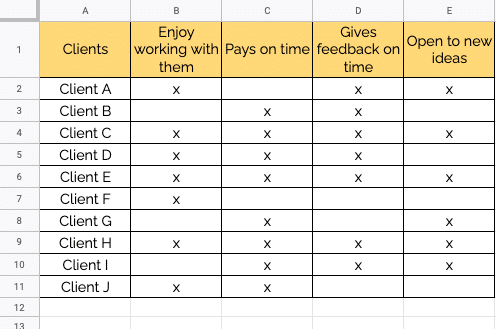
You are busy. You are trying to do all the things. You’re doing some marketing, but you have no idea if the lead you got last week is from social media or a blog post you wrote. Are the many hours you’ve put into creating the perfect Instagram platform even working?
Your time is valuable, and you’d love to know you’re spending it on the things that will get you the right type of clients, the ones who follow your carefully crafted systems, the ones who pay on time, the ones you love working with.
How do you measure progress with your marketing so you’re confident time is being spent in the right places?
Marketing progress means better clients, not just more leads
Before trying to measure progress, it’s important to think about what progress means to you.
What does progress actually even look like? Some of you might just want more leads but are they all going to be your ideal audience? Unless you are sharing the right messages to the right kinds of people and have measures set in place to disqualify and qualify people through the process, you’ll just be attracting anybody and everybody….or no-one at all.
Progress through marketing is often slow. It’s not a storm of new leads, but rather a steady drip feed. It’s not only new clients, it’s sign-ups to newsletters, new followers and engagement on social media, a steady increase of organic traffic, a new blog showing up in your top ten pages on Google Analytics. It’s a steady stream of conversations with prospects, people attending your events, people signing up to receive free things, like guides or checklists on a particular topic. Progress is a journey and won’t always happen right away.
A lead will come to you from one social post or a particular blog but that is likely not the only marketing that helped them along their buying journey. They will most likely have seen multiple blogs, dozens of social posts, seen you speak at an event, attended a free webinar but perhaps they weren’t yet ready to buy on all those occasions. So they continued to follow you on socials and read your new blogs and when they were ready, they took action. It just so happened they took action on a particular blog or social post.
You do get people who buy faster and may be convinced to get in touch from a particular blog, but those are few and far between.
Define your goals so you have something to measure against
In order to know what’s working, you need to have something to measure against. A goals session is a great way to create these measurements. Whilst you want to define specific marketing goals (reach, engagement, users, bounce rate etc.) it’s also helpful to have a look at and define specific business goals (finance, team, clients, systems).
If you are wanting to increase your monthly client fee, you need to set regular service reviews and create marketing items (website pages, blogs, PDF guides, graphics) that really show the value of your products and services.
If your team is feeling stressed or over capacity, you may need to change your systems or hire new team members. You do this by creating marketing materials that will attract new team members; a careers page, testimonial videos, social posts about the team and the new roles, or even a blog.
If you are looking to get more clients in a particular niche, that will affect the key messaging in your marketing.
If you want to improve your onboarding process or system, you use marketing elements to define the process, create graphics on ‘the way’, create videos, landing pages, and build forms.
Select a small team to go through a goals session with you. At PF, we do this as the first stage of Foundations.
Work through your personal goals first because these integrate so closely together with your business goals. Ask yourself:
- What work do you enjoy?
- Do you want to travel?
- How many hours per week do you want to work?
- What would you like to do more/less of?
Together with your team, work through your firm’s goals. Talk about:
- Finance goals – average monthly fee, year-end revenue, net profit percentage
- Pricing goals – how often you review client pricing, how you price your services
- Team and hiring goals – number of employees, number of new hires needed, types of positions
- Client goals – number of clients, number or prospects, conversion rate
- Systems goals – what your hiring process, onboarding process, and qualifying process look like
- Event goals – number of attendees, amount of money made, services signed up to
Define goal dates i.e. “By January 2023, we will have completed X”. Define short term goals and long term goals. Make sure your goals are realistic but also ambitious. Once you have agreed on your goals, document them so you can refer back to them later.
For example, if you are running an event, once the event is finished you will want to refer back to your goals to see how you did. You’ll look at things like:
- How many people attended in comparison to the goal?
- How many people signed up to services following the event and what was the goal conversion rate?
- What was the goal for how much money you wanted to make and how much did the event bring in?
Talk to your team. Do they have everything they need to make progress with your firm’s marketing?
It’s great to set goals, but you need to execute them to actually get things done and see progress.
In Atomic Habits, James Clear explains “There is a common mistake that often happens to smart people — in many cases, without you ever realizing it. The mistake has to do with the difference between being in motion and taking action. They sound similar, but they’re not the same.
When you’re in motion, you’re planning and strategizing and learning. Those are all good things, but they don’t produce a result. Action, on the other hand, is the type of behavior that will deliver an outcome.
Sometimes motion is useful, but it will never produce an outcome by itself. It doesn’t matter how many times you go talk to the personal trainer, that motion will never get you in shape. Only the action of working out will get the result you’re looking to achieve.”
Regularly check in with your team on the team goals you set. Do your team actually have everything they need to take action and make progress, rather than simply set goals?
Ask questions such as:
- What is your team’s capacity? You could create a capacity planner. There are so many platforms and tools to do this but you could even start simple with a Gsheet and a few formulas.
- Do you need to hire more people? Whilst it’s important to track capacity and ensure that the systems and processes are working as they need to be, it may also be time to hire new team members.
- Does anyone in the team need training? If the workload is low but the stress level is high, certain team members may need training in a particular area to gain skills and confidence.
- What is the overall happiness level? Monitor their happiness around work. Have regular individual check-ins to find out what could be improved or changed to improve morale in the workplace.
You could also talk to your team about the prospects and clients. They will have a better understanding of the type of clients the firm is attracting as they are the ones dealing with the clients every day. Are the clients you have the right ones? Do your team enjoy working with them? Are the clients paying on time?
Something else to look at is, how much time are you and your team really putting in to get marketing done? Is there an amount of commitment required to make it work?
Review your clients to make sure you’re not making progress in the wrong direction
Regularly check in with your clients around any of the client, finance and systems goals you set. When it comes to finance goals, have regular service reviews to allow room to increase average monthly fees where needed.
Review your client list to see if they are still your ideal clients. Create a Gsheet with a list of all your clients in the first column. Have values or questions relating to expectations in row A of columns B, C, D etc. You could ask things like “do they pay on time?”. Then tick or cross if that client lives up to those values or expectations within the Gsheet.

When things don’t go according to plan, work out what system or process needs to change.
Track all your marketing numbers so you know where you stand month on month
If you’re not tracking your marketing numbers on a monthly basis – or are only looking at sales and leads – you’re missing the whole picture. And your marketing decisions will suffer. You know your clients will only be able to measure progress by tracking their financial numbers, and the same applies to your marketing. Many accountants we meet face the same difficulties in tracking their marketing numbers as their own clients do tracking their financials. We often hear “I’m not really doing any marketing so there’s nothing to track” or “I’m too busy” or “I don’t know what I need to be tracking”.
There are a lot of marketing analytics out there, an infinite amount it seems. So choosing which ones to track can be a challenge. It may even lead you to wonder why bother tracking any at all? Or even worse, you may keep trying different marketing actions based on only a few numbers. Potentially losing money and not getting the answers you really need.
The most important things to track include:
- Number of clients
- Number of prospects (ideally segmented by prospect type)
- Conversion rate (leads converted to clients)
- Average conversion time (in days, weeks, or months)
- Number of website visits (split by landing page)
- Number of pageviews
- Average client value
- Number of followers on each social media platform
- Number of proposal sent and accepted
Read this blog on the marketing numbers your accounting firm needs to track and why to choose the list of metrics best suited to help you measure progress for YOUR firm.
The best way to get started tracking your marketing numbers is to create a Gsheet of all the things you’d like to track and then spend time pulling the numbers into the sheet. Once done, you need to compare the numbers to the previous few months so you can see how you are doing.
This does take time. If you aren’t ready to do this yourself or just don’t have the time, the PF Co-pilot and Tracking service is just the thing you need. It’s like management accounts for marketing, focused specifically on your most important numbers.
Once you have your numbers, you need to compare them to your goals. Have you reached your targets? How far off your target are you? Do the goals still feel realistic or do they need to be adjusted?
Don’t give up too soon
One of the worst things to do when it comes to marketing is give up too soon and it’s one of the things that we see most commonly when people believe marketing isn’t working.
Lindsay and her team at Saint & Co started blogging regularly a couple of years ago and by persevering, they’ve recently seen some great results.
“Blogs definitely work well for enhancing client relationships with existing clients AND gaining new ones. We have our clients categorised into industries and email the more important blogs to clients. Some get put straight on our website. We get lots of positive feedback from existing clients who see us as being proactive because of it and feel the benefit of our emails.
BUT they also mention things to their business friends who get nothing from their accountant and we’ve had referrals and gained clients because of it. Our Google enquiries have noticeably increased in the last 6 months off the back of people looking at certain articles. We’ve had 20 clients contact us with thanks for sharing our information.” – Lindsay Farrer, Saint & Co
If the measurement of a certain item has dropped from one month to the next, give it a few months before you make a change. The drop could be due to a number of things and it’s important to wait until you see an obvious trend before making adjustments. Think about seasons and holidays – are people away for the Summer break? Is it tax season? Is it Christmas time? Have there been changes in the economy that might mean people need an accountant more, or less right now?
When you realise something isn’t working, don’t stop marketing altogether – adjust your time and energy
The great thing about tracking your numbers is it shows you what’s working. It can also hint towards what isn’t working. So what do you do when you find something that isn’t working? For example, you’ve spent all your time on Facebook and since tracking your numbers, you’ve realised your ideal clients aren’t spending time there. Do you just stop?
You can still post on Facebook, but spend the majority of your time and effort on the platform where your ideal audience actually are. If you don’t know where they are, do some searching to find out. Look where your current clients spend their time. Think about their personality traits – are they more creative and visual people (Instagram is your best bet here) or are they more corporate (Linkedin could be the answer for these types of people)?
Don’t just stop what you are doing, but rather adjust your time and energy. Remember to give things time before making changes. Progress can be slow and steady, or it can come in waves. Don’t compare your progress to someone else’s. You are your own competition.

